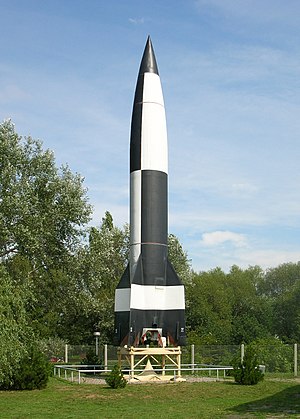V-2
The V-2 rocket (German: Vergeltungswaffe 2) was the world's first ballistic missile and first human object to fly in space.[4] All modern rockets are based on the V2 design.[5]
| Aggregat-4/Vergeltungswaffe-2 | |
|---|---|
 Peenemünde Museum replica of V-2 | |
| Type | Single-stage ballistic missile |
| Place of origin | Nazi Germany |
| Service history | |
| In service | 1944–1952 |
| Used by | |
| Production history | |
| Designer | Peenemünde Army Research Center |
| Manufacturer | Mittelwerk GmbH |
| Unit cost | 100,000 RM January 1944, 50,000 RM March 1945[1] |
| Produced | 16 March 1942 – 1945 (Germany) Some assembled post-war |
| Specifications | |
| Mass | 12,500 kg (27,600 lb) |
| Length | 14 m (45 ft 11 in) |
| Diameter | 1.65 m (5 ft 5 in) |
| Warhead | 1,000 kg (2,200 lb); Amatol (explosive weight: 910 kg) |
Detonation mechanism | Impact |
| Wingspan | 3.56 m (11 ft 8 in) |
| Propellant |
|
Operational range | 320 km (200 mi) |
| Flight altitude |
|
| Maximum speed |
|
Guidance system |
|
Launch platform | Mobile (Meillerwagen) |
The first successful launch was from Peenemünde on 3 October, 1942, reaching a height of 192 km.[6]: 7 The V2 was designed by Nazis to bomb London, Antwerp and other European cities. It travelled at four times the speed of sound so was impossible to shoot down.
The first V-2 used as a weapon exploded in Paris on 8 September 1944, with a second rocket exploding in London later that day.[6]: 10 Over 3,000 V-2s were used by the German Wehrmacht against Allied targets in World War II, resulting in the death of about 7,250 military personnel and civilians.
The victors used captured V-2 rockets to start their space and missile programs. In the United States they were helped by the team of German rocket scientists from Peenemünde, led by Wernher von Braun. They had surrendered to the US at the end of the war.
The first US-assembled V-2, made from parts captured in Germany, was launched from White Sands, New Mexico, in April 1946.[6]: 21 There were 66 V-2 rocket flights, the last on October 29, 1951.
Development
changeIn the late 1920s, a young Wernher von Braun bought a copy of Hermann Oberth's book, Die Rakete zu den Planetenräumen (The Rocket into Interplanetary Spaces).[7] Starting in 1930, he attended the Technical University of Berlin, where he assisted Oberth in liquid-fueled rocket motor tests.[7] In 1933 he went to work for the Army designing and building rockets. The final, biggest rocket was the A-4, later called V-2.
Production
changeOn 22 Dec. 1942, Hitler signed the order for mass production, when Speer assumed final technical data would be ready by July 1943. However, many issues still remained to be solved even by the autumn of 1943.[8] Around this time, production was shifted to the concentration camp of Dora-Mittelbau where an estimated 20,000 prisoners died producing V-1s and V-2s.
Test launch was recovered by Polish resistance on 30 May 1944[9] and rocket from Blizna was transported to the UK during Operation Most III.
References
change- ↑ Kennedy, Gregory P. (1983). Vengeance Weapon 2: The V-2 Guided Missile. Washington, DC: Smithsonian Institution Press. pp. 27, 74.
- ↑ 10% of the Mittelwerk rockets used a guide beam for cutoff.
- ↑ Neufeld, Michael J (1995). The Rocket and the Reich: Peenemünde and the Coming of the Ballistic Missile Era. New York: The Free Press. pp. 73, 74, 101, 281. ISBN 9780029228951.
- ↑ Peenemuende, Walter Dornberger, Moewig, Berlin 1985. ISBN 978-3-8118-4341-7.
- ↑ NOVA science program(s). Sputnik declassified. Public Broadcasting Service (PBS). 2008.
- ↑ 6.0 6.1 6.2 Furniss, Tim (2001). The History of Space Vehicles. London: Grange Books. ISBN 978-1-84013-370-7.
- ↑ 7.0 7.1 Wernher von Braun#Early life.
- ↑ Speer, Albert (1995). Inside the Third Reich. London: Weidenfeld & Nicolson. pp. 496–497. ISBN 978-1-84212-735-3.
- ↑ # (Polish) Michał Wojewódzki, Akcja V-1, V-2, Warsaw 1984, ISBN 978-83-211-0521-5
References
change- Oberg, Jim; Sullivan, Dr. Brian R (original draft) (March 1999). "'Space Power Theory". U.S. Air Force Space Command: Government Printing Office. p. 143. Archived from the original on 3 February 2009. Retrieved 28 November 2008. 24,000 fighters could have been produced instead of the inaccurate V-weapons.
- Harris, Arthur T; Cox, Sebastion (1995). Despatch on War Operations: 23rd February, 1942, to 8th May, 1945. Psychology Press. p. xliii. ISBN 978-0-7146-4692-3. Retrieved 4 July 2008.
- King, Benjamin; Kutta, Timothy J. (1998). Impact: the history of Germany's V-weapons in World War II. Da Capo Press.
Further reading
change- Dungan, T.D. (2005). V-2: A Combat History of the First Ballistic Missile. Westholme Publishing Llc. ISBN 978-1-59416-012-7.
- Huzel, Dieter K. (ca. 1965). Peenemünde to Canaveral. Prentice Hall Inc.
- Piszkiewicz, Dennis (1995). The Nazi Rocketeers: Dreams of Space and Crimes of War. Praeger Publishers. ISBN 978-0-275-95217-4.
Other websites
change- The dictionary definition of v-2 at Wiktionary
- Media related to V-2 missiles at Wikimedia Commons
- History of Peenemünde and the discovery of the German missile development by the Allies
- "Chute Saves Rockets Secrets", September 1947, Popular Science article on US use of V-2 for scientific research}
- Reconstruction, restoration & refurbishment of a V-2 rocket[permanent dead link], spherical panoramas of the process and milestones.